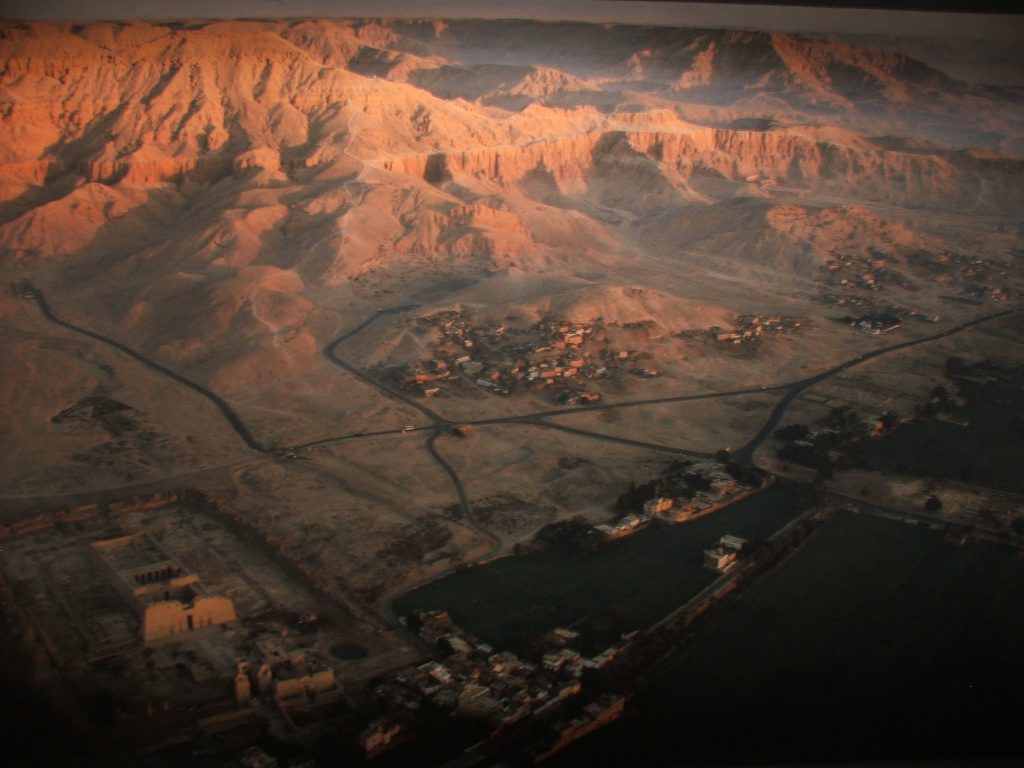
Our project is tied up with the land of Egypt, and not only because the texts we’re studying are written in Coptic. Egypt has a unique place in the study of the ancient Mediterranean because of its proverbial “dry sands”. Most of the population has always lived along the narrow stretch of the Nile valley – extending nearly 1200 km from Aswan in the south to Alexandria in the north, but only 3-20 km wide at any point along its course. On each side of the valley stretches the mountainous desert, filled over the centuries with towns, tombs, temples, churches, and monasteries. While elsewhere ancient texts often rotted away, the extreme dryness of these sites in Egypt has preserved unparalleled quantities of texts from the ancient world, allowing us to study many aspects of daily life in rich detail – including magic.
But these texts are not found evenly throughout Egypt – their distribution has been affected by a number of factors: which sites were inhabited when, which were preserved or damaged by the accidents of history, and which were excavated, when, and by whom. Many of Egypt’s largest towns have been continuously inhabited since ancient times, so that the remains of the ancient city of Heliopolis, for example, lie under part of modern Cairo, largely inaccessible to excavators. Many sites in the south now lie under the artificial Lake Nasser, created by the construction of the Aswan High Dam in the 1960s, destroying any papyri that would have lain buried beneath them. And while modern official excavations will usually follow best practice and carefully record every object they unearth, early archaeologists, as well as those searching for objects to sell, often took only the pieces they considered the most interesting, abandoning or ignoring others. For all of these reasons, it’s worth looking at where our magical texts come from, to get a sense of how our evidence may be biased in favour of particular well-attested sites.
Our database contains 502 Coptic magical texts at present. Each one has three geographical locations associated with it – purchase site, find spot, and writing spot. As with many other fields, we very often lack enough information to provide entries for every papyrus. A huge number of the manuscripts we are studying were the result of illegal or unrecorded excavations, usually by native Egyptians; from the nineteenth century onwards farmers would often find objects while looking for sebakh (“fertiliser”) – mud bricks from ancient sites – while others looked deliberately for objects to sell to foreign visitors. Until Egypt’s 1951 law prohibiting the export of antiquities and its application in international law over the following decades, it was the norm for foreign collections to buy objects from such unofficial excavations, often in huge quantities, and such sales were rarely accompanied by even basic information about their find spot. For this reason, we find that it is useful for us to record the site where the manuscripts were purchased, when this is known, even if this is one of the two major antiquities markets in Egypt – Cairo and Luxor – since this can give us a rough idea of where objects were found. Nonetheless, of our 502 Coptic magical manuscripts, only 180 have secure or inferred provenances; in most cases we only know that they likely came from somewhere in Egypt.
Where we are lucky enough to have a known find spot this is even better, since it tells us the last place that the manuscript was used; find spots may be recorded in an excavation report, or reported by a seller. The location where the text was created – the writing spot – is often probably close to the find spot, since we tend to assume that people didn’t move around much in the distant past. Nonetheless, we know that people and texts did circulate throughout Egypt, and the larger Roman and later Islamic empires, so that the find spot of a text might not be its origin. It’s rare for us to have a separate writing spot for a magical text though – this is more common with letters, where the writer may give information which tells us where they were living when it was written.
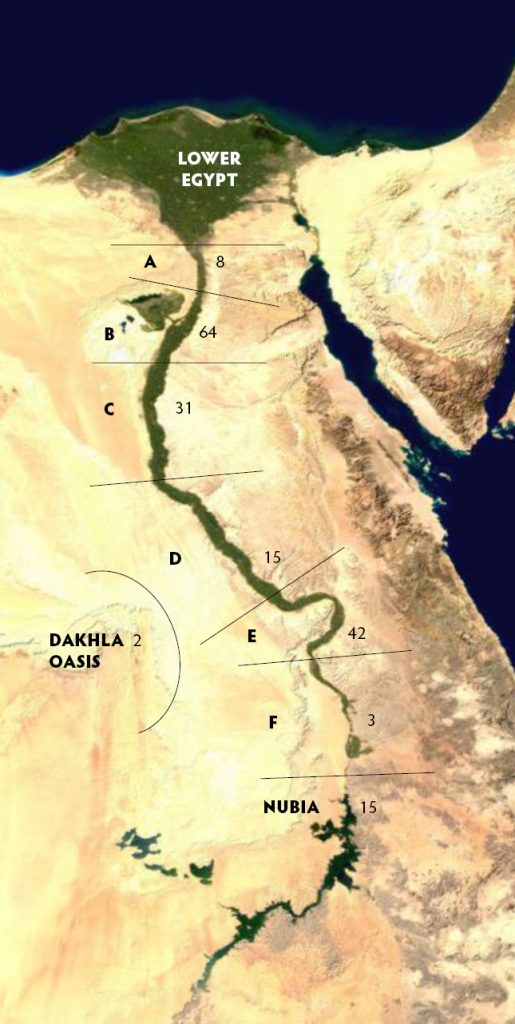
So let’s look at where our Coptic magical papyri come from. The image here shows the raw numbers for the find spots of the 180 manuscripts from our database which have this information. These have been divided into six regions – A to F, according to a scheme devised by Paul E. Kahle to represent the linguistic divisions found in the Coptic language, with a few extra regions added – Lower Egypt, Nubia, and the Dakhla Oasis.
We can see straight away that the division is very unequal: we have no texts which are known to come from Lower Egypt – the region north of modern Cairo which contains the huge plain of the Nile Delta, the most fertile and most densely populated part of the country, and we likely have no texts from Alexandria – the capital city under the Romans, the seat of the Coptic patriarch, and the religious and intellectual centre of Egypt. These are very significant omissions. By contrast, two areas are very well-represented, regions B and E. These correspond respectively to the Fayum Oasis, a natural depression which branches off from the Nile Valley south of Cairo, and the area around Thebes, modern Luxor.
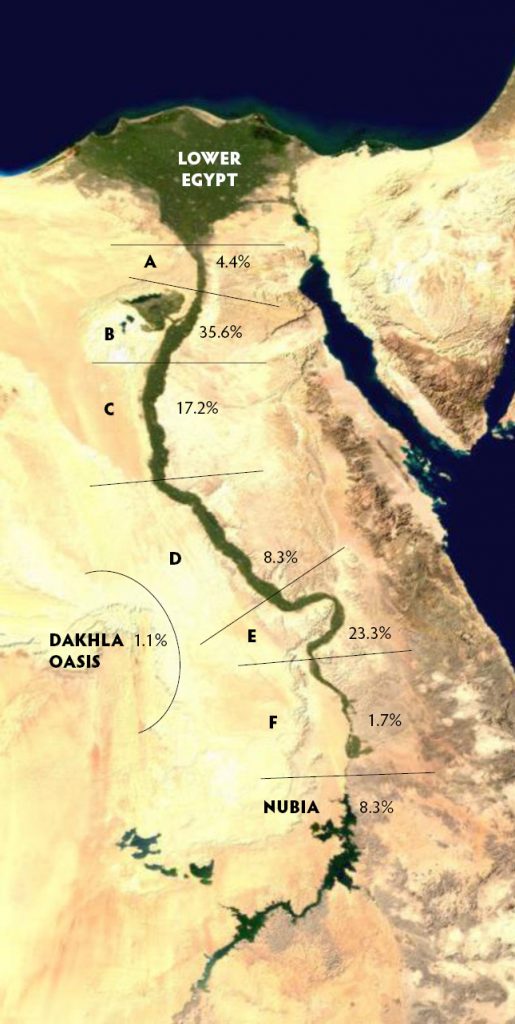
If we convert the raw numbers into percentages, we can see that manuscripts from Thebes and the Fayum make up a total of 58.9% of our total, dominating our sources. Both sites were major centres of excavations from very early in the history of Egyptology – already in the 19th century Egyptians and foreigners would dig in the abandoned towns of the Fayum, and the temples and tombs on the west bank of Thebes continue to be rich sources for finds. The pharaonic sites around Thebes were heavily re-used by later Christians – the Mortuary Temple of Ramesses III, known as Medinet Habu, was in Late Antiquity a town called Djeme, containing four Christian churches, while the temple of Hatshepsut at Deir el-Bahri had been converted into the Monastery of Phoibammon. The whole desert was transformed into a honeycomb of monasteries and cells for ascetics, with caves and pharaonic tombs being used as homes and oratories by their new inhabitants. The Theban region is hugely important for modern Coptology – Alain Delattre and Paul Heilporn estimated in 2005 that nearly half of all surviving Coptic documentary texts came from Djeme and its surroundings, allowing us to reconstruct the lives of many its inhabitants in surprising detail. While the Fayum is less studied, its towns and temples have yielded many texts which remain to be fully exploited – we discussed in an earlier post the fascinating case of Phoibammon, a monk-“magician” who lived in Naqlun in the Fayum. Both Thebes and the Fayum were important sites in the 19th and early 20th-century antiquities trade – many of the most famous Egyptian artefacts passed through the market in Luxor, and although the market in Medinet al-Fayum was far smaller, it served as a hub through which items often passed through it on their way to the market in Cairo, the largest in the country.
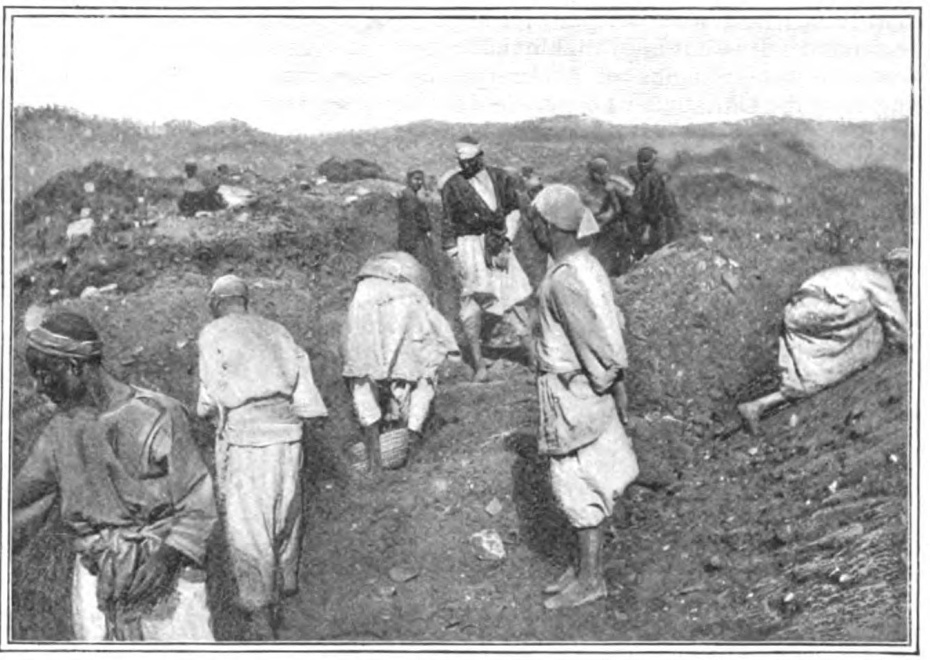
If the other regions are less well-represented, they are often still important. Region C contains Oxyrhynchus, a town whose rubbish dumps have provided us with one of the largest finds of Greek papyri, as well as a much smaller number of Coptic texts. It also includes Ashmunein, Greek Hermopolis, and the nearby Antinoopolis, which is still the subject of ongoing excavations which continue to yield interesting texts. 17% of our provenanced texts come from this region, but this is due in a large part to the fact that Coptic was a language with important dialectal variation; scholars often note that texts are written in a “Middle Egyptian” variety of Coptic, and we have assigned “Middle Egyptian” texts to this region. This method can also be used to determine the likely origin of other texts – especially distinctive is the dialect spoken in the Fayum Oasis. In the Fayumic dialect, ‘r’ was often pronounced as ‘l’; the Coptic word for man, rōme in the predominant Sahidic dialect, was lōmi in Fayumic.
Even sites with only a few manuscripts can nonetheless be important – in another earlier post we discussed the magical texts produced by the Manichaean community in Kellis in the Dakhla Oasis. Although the Coptic magical texts from here are few in number, the richness of the documentary texts found in the same locations make them an important complement to our picture, otherwise dominated by the Fayum and Thebes.
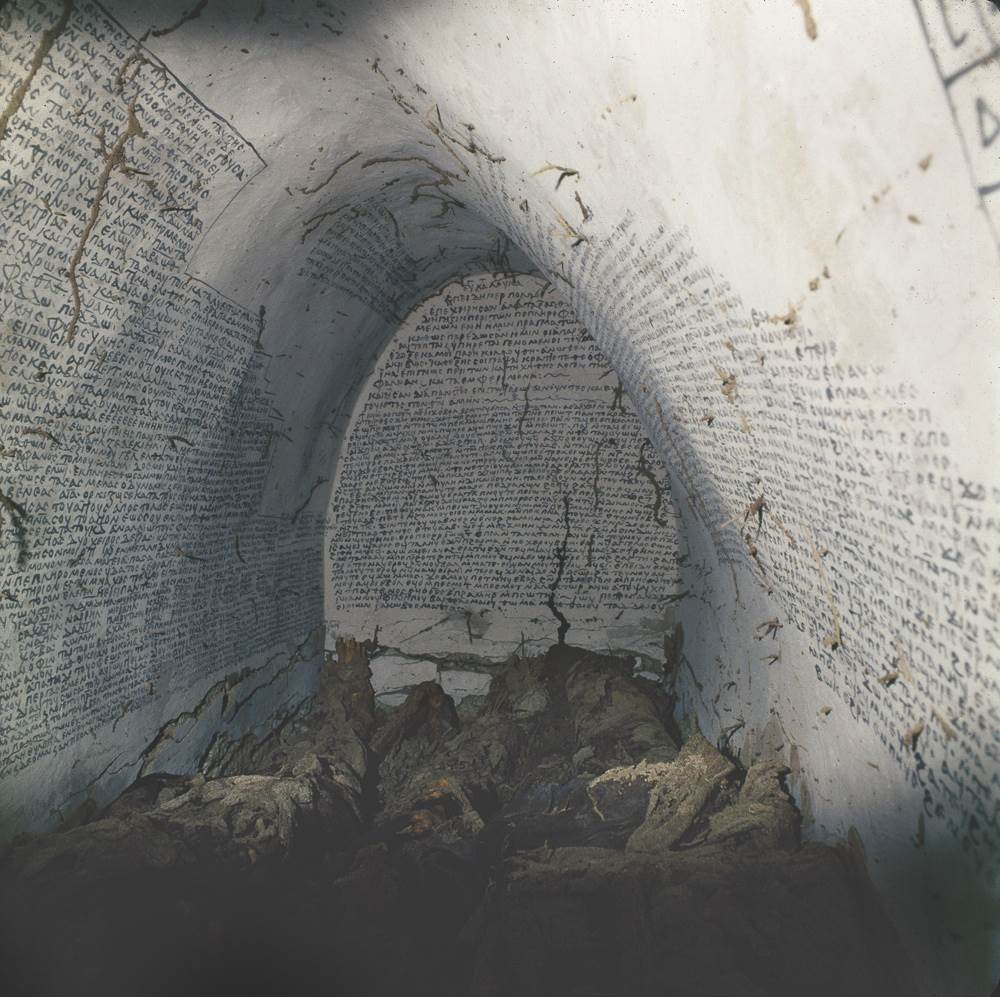
We should also note that not all of our texts come from Egypt. 15 of the manuscripts in our database are from Nubia, a region which converted to Christianity in the sixth century and fell under the spiritual authority of the Patriarch of Alexandria, but which had its own written language, Old Nubian, used alongside Greek and, to a lesser extent, Coptic. The Coptic magical texts from Nubia are an interesting mix of wall inscriptions, paper and ostraca, many not fully published, which show their own distinctive features. We should also note that although we are treating Nubia as a single region here, it was huge, stretching far south of the southernmost point of our map – the distance from Dongola, where several of our Nubian texts were found, to Aswan in southern Egypt is over 800 km, nearly the length of Egypt from Aswan to Cairo. Nubia was also politically divided – in the sixth century it was split into the kingdoms of Nobatia, Makouria and ‘Alwa, from north to south, and we have texts from the first two of these.
In this survey we’ve tried to give a brief overview of the current state of our knowledge about the Coptic magical papyri; as we continue to work on them we hope to be able to identify more find spots as we research the manuscripts’ collection histories and material and linguistic features. Knowing where texts come from is important, not only because we can more fully understand them when we know their geographical context, but also because we need to be aware of the limitations of our sources, which often come from a relatively small range of sites.
References and Further Reading
Al-Azm, Amr & Katie A. Paul. “How Facebook Made It Easier Than Ever to Traffic Middle Eastern Antiquities”. World Politics Review. 14 August 2018. [URL]
A fascinating look at the modern trade in illegal antiquities from Egypt, as well as Syria and Iraq.
Choat, Malcolm. “Provenance and the papyri”. Markers of Authenticity. 25 April 2016. [URL]
A useful discussion of provenance and the problems of the illegal antiquities trade in relation to modern papyrology.
Delattre, Alain & Paul Heilporn. “Preface”. In Et maintenant ce ne sont plus que des villages : Thèbes et sa région aux époques hellénistiques, romaine et byzantine. Actes du colloque tenu à Bruxelles, déc. 2005, edited by
Delattre, Alain & Paul Heilporn. Brussels: Association Égyptologique Reine Élisabeth, 2008, v-x.
A discussion of the Theban region and its importance in papyrology.
Grenfell, Bernard P. “The Oldest Record of Christ’s Life: The First Complete Account of the Recent Finding of the ‘Sayings of Our Lord'”. McClure’s Magazine 9 (1897): 1022-1030. [URL]
A description of the excavation of Oxyrhynchus in the 1890s by one of the chief excavators.
Hagen, Fredrik & Kim Ryholt. The Antiquities Trade in Egypt 1880-1930: The H.O. Lange Papers. Copenhagen: Det Kongelige Danske Videnskabernes Selskab, 2016.
A fascinating study of the antiquities trade in the late 19th and early 20th century, providing much of the background to the acquisition of papyrology collections by museums and universities.
Kahle, Paul E. Bala’izah. Coptic Texts from Deir el-Bala’izah in Upper Egypt, vol. 1. London: Oxford University Press, 1954.
An edition of Coptic texts which also contains a very thorough discussion of the dialectology and history of the Coptic language. Kahle introduces the regions used here on page 51.
Łajtar, Adam and Jacques van der Vliet. Empowering the Dead: The Texts from a Medieval Funerary Complex in Dongola. Warsaw: Raphael Taubenschlag Foundation, 2017. URL
Contains the edition of the texts from the Tomb of Georgios in Dongola, Nubia.
Mazza, Roberta. “The Illegal Papyrus Trade and What Scholars Can Do to Stop It”. Hyperallergic. 1 March 2018. [URL]
A very rich article on the modern illegal antiquities trade.
